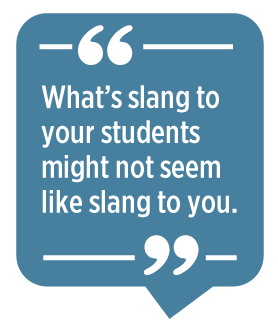|
 English learners want to master slang for many reasons—to
understand popular songs, to get the jokes in movies and television shows, and
to fit in at school. But for teachers, it can be hard to know where to start
and what to teach. This article aims to give you tools to plan your lessons and
some activities to get you started.
English learners want to master slang for many reasons—to
understand popular songs, to get the jokes in movies and television shows, and
to fit in at school. But for teachers, it can be hard to know where to start
and what to teach. This article aims to give you tools to plan your lessons and
some activities to get you started.
How to Think About
Slang
Teaching Slang Is
Teaching Vocabulary
Admittedly,
teaching slang has some differences from teaching “regular” vocabulary. It’s
mostly low-frequency words, which makes a difference in creating word lists. It
has an expiration date—some words go out style quickly—and it’s strongly tied
to culture, especially popular culture. And it’s found more in informal
speaking and listening than in reading and writing.
However,
there are some similarities with more standard language, which doesn’t stand
still either. For example, because of social changes, what are now flight attendants used to be stewardesses. Technology causes us to create new words for
familiar devices, like landline for what we used to call the phone. As with slang, how and when we use the words is
important: We don’t pack our ordinary conversations with high-level TOEFL
words, and if we did, we might seem pretentious.
You Know More Than You
Think
If you don’t
keep up with the latest pop culture, you might worry that you aren’t qualified
to teach slang. However, what’s slang to your students might not seem like
slang to you because you use it without thinking—common slang phrasal verbs
like rip off and hang out are often
unfamiliar to English learners. While slay (perform really
well) and no cap (no exaggeration) are relatively new, most
currently used slang is not. The word cool has been around
for more than 100 years; people still say awesome and nerd, and you can find classic slang like drop
dead gorgeous and play dumb in the latest “top
40” songs.
Choosing Media, Materials,
and Activities
Follow Your Students’
Lead
You can make
your own lists of common phrases (some examples are in the appendixes).
However, I recommend you ask your students to help you. Chances are good that
they are already hearing slang in conversation, on television, or in popular
music. You can focus on a popular television show, movie, or song that the
students request. Or, they can bring in words and phrases they have heard but
don’t understand or know how to use. The biggest obstacle for students is often
figuring out how to spell what they hear zipping by, so recommend they watch
television with the captions on, and ask them to include the sentence or
context to ensure you know what they are talking about. One caveat: Have them
submit their lists in written form unless you’re comfortable dealing with “bad”
words during class.
 Don’t Be Afraid of
Authentic Materials Don’t Be Afraid of
Authentic Materials
Although
authentic materials may be more difficult and have fewer slang words than an
exercise you created, authentic materials are the reason students want to learn
slang in the first place. I recommend animated television shows and movies,
which tend to include more visual cues, sound-effects, exaggerated facial
expressions, and physical comedy than live-action sitcoms.
Though it’s
usually true that students need to know most of the words in a text or audio
file to understand it, I would argue that these features of animations greatly
reduce the linguistic load. On The Simpsons, for example,
Marge’s sigh and Homer’s “D’oh!” require no translation. My students are able
to enjoy Bart’s antics and Lisa’s frustrations even if they miss some of the
jokes based on language, and they feel a sense of accomplishment in
understanding a “real” video as opposed to an exercise designed for English as
a second language students.
If Language Is Culture,
Slang Is Pop Culture!
TV scripts
and song lyrics that feature slang can also feature many references to
culture—and especially pop culture—so be sure to put these in the word list.
For instance, characters in The Big Bang Theory often talk
about popular movies, altering the titles to make a joke. Superhero movies,
such as Deadpool, rely on the audience’s understanding of
pop culture, from The Lord of the Rings to Facebook. Bruno
Mars’s hit “Uptown Funk” requires a knowledge of American peanut butter brands
(“smoother than a fresh jar of Skippy”), and Taylor Swift’s latest hit,
“Cardigan,” talks about walking the “High Line”—which sounds like a metaphor,
but is actually a park in New York City.
For music in
particular, the crowdsourced site Genius can help when you’re
not sure what’s being referenced. Explanations of slang and cultural references
from popular movies can be found at Slang
City.
Keep
Listening Exercises Short
It’s
tempting to show your students an entire movie—and they might ask for it—but
they’ll get a lot more out of a 5- to 6-minute clip and a limited wordlist.
Once your students are familiar with the language they’ll need, write
comprehension questions or create cloze exercises from an online script. If you
choose a cloze exercise, focus on the list of unfamiliar words rather than
randomly skipping every fifth word. Give them a chance to guess which word goes
where before you play the video, and play it twice. Actors—especially in
comedies—speak much more quickly than your average English teacher.
Slang
Activities
Ideally,
your students have conversation partners who are native speakers to try out
their new vocabulary on. Even if they do have that option, you should create as
many opportunities as possible for them to practice both listening and speaking
in the low-stakes environment of the classroom. Here are a few ways to get
started.

Start Small With
Exclamations!
One simple
way for students to dip their toes into the slang pool is with exclamations.
These short phrases stand alone, so students don’t need to use them in a
sentence. After reviewing the list of words and phrases (see Appendix A), put
pairs of students in groups or breakout rooms to take turns making statements
and responding with exclamations. Many of these have more than one possible
response.
Examples
Speaker 1: I
finally got an A in biology!
Speaker 2: Way
to go! (Congratulations, great job!)
Speaker 1: I
finally got an A in biology!
Speaker 2: You
and me both. (Me too)
Afterwards,
in a whole class debrief, discuss which answers were most popular and how they
were used.
Incorporate Slang Into
Traditional Games
Another way
to get started is through a typical icebreaker game like Find Someone Who (see Appendix B). First, introduce students to some common slang words. If the
students already know each other, switch up the questions to ask about facts
they are less likely to know.
Examples
-
Find someone who has spent
too much time doom-scrolling (obsessively reading
about bad news online) during the pandemic.
-
Find someone who has freaked out (gone crazy from anxiety or fear) in
the last few weeks. Why did they freak out?
For online
classes, create breakout rooms of two students each, and re-create the breakout
rooms every 1 or 2 minutes, so that the students get to talk to as many
classmates as possible.
Get Creative With
Dialogues: Can I Get a ______?
In this
activity borrowed from improv comedy, dialogues are inspired by suggestions.
The teacher asks students questions to get a location, a relationship, and a
word. It’s helpful to be specific. For example:
Places
-
Can I get a place you
wouldn’t want to go on vacation?
-
Can I get a kind of
restaurant?
-
Can I get a place you’ve
been angry?
Relationships
-
Mother/child
-
Customer/waiter
-
Teacher/student
Words
The set of
words is written on the board (real or virtual), and pairs of students are
tasked with using them as the basis for a dialogue—which must, of course, also
include words from a list of slang. If students are both advanced and
adventurous, they can make up the dialogue as they go along, but most students
will want to write it down before they deliver it to the class.
If you are
less comfortable eliciting suggestions, you can use an improv randomizer called Can I Get A… to
create them for you.
Following is
an example dialogue using a basketball court (location), boss/employee
(relationship), and octopus (word):
Employee: This
basketball game slaps! Thanks so much for inviting
me.
Boss: You
deserve it. You really knocked yourself out on the coding project.
Employee: Check out that player! It looks like she has eight
arms.
Boss: Yikes! I think she does…
Wrapping It
Up
These are
just a few ways to bring the colorful language of slang into your classroom.
I’m sure that whatever methods you choose to bring this new lexicon to your
students, you’re going to slay! No cap.
Other Useful Resources
for Teachers
-
Green’s
Dictionary of Slang: An
excellent, well-researched dictionary of slang from today and the past.
-
Forever
Dreaming Transcripts:
Transcriptions of popular television shows and movies.
-
Urban
Dictionary: Use with
caution. While this crowdsourced slang dictionary has many great entries, it
also has many inaccurate ones, often entered as jokes. Profanity is common.
A.
C. Kemp has been a lecturer in English
language studies at MIT since 2007. She has a master’s degree in applied
linguistics from the University of Massachusetts/Boston. A. C. has also
presented extensively on teaching strategies for vocabulary acquisition. Since
2002, she has been the director of Slang
City, a website devoted to American slang and colloquial
language. She also has a strong interest in ITA training, for which she created
the User-Friendly Classroom Video
Series in 2016. |